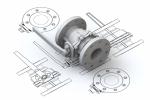 Let’s be clear, working in a multi-CAD environment is not uncommon. For a variety of reasons, manufacturers can end up with more than one CAD system in operation. This could be for many reasons, including supplier driven demands, as a result of an acquisition, or due to customer requirement.
Let’s be clear, working in a multi-CAD environment is not uncommon. For a variety of reasons, manufacturers can end up with more than one CAD system in operation. This could be for many reasons, including supplier driven demands, as a result of an acquisition, or due to customer requirement.
But, while it is a common situation to be in, it doesn’t mean it’s easy to manage. In fact, the pressures of coping with multi-CAD can be both costly and time consuming. Within this environment, it is becoming increasingly clear to many managers that there are inefficiencies and problems arising from operating with multiple CAD systems. Core issues include the need to:
- Improve Software Cost Reduction – having different CAD platforms within the business can result in a higher number of software licenses, and correspondingly high software running costs. Bringing the whole organisation onto one CAD software platform can result in significant cost savings with a dramatic reduction in the number of software licenses.
- Reduce Maintenance Costs – maintaining multiple software products means having multiple maintenance agreements. Having just one CAD software platform will reduce the number of maintenance agreements.
- Improve Information Sharing - changes within organisations, including merging of departments and working with new suppliers can be slowed down, if they’re not all using the same software platforms. Communication and information sharing barriers can arise; including an inability to easily share product and process design data between different software systems.
- Reduce Product to Market Time – problems with sharing data across different CAD software products can also hamper the core business of readily getting new products out to the market place. Data may have to be reconstructed in some manner, or time-consuming and expensive data translation processes developed.
What are the benefits of CAD Consolidation?
For the sake of expediency, many businesses continue to run with a mix of systems until problems start to seriously impact on competitiveness. It can be difficult to find time for staff to attend necessary training, and initial productivity lost as they become familiar with a new CAD system.
A hard-nosed, critical cost analysis of the inefficiencies caused by having multiple CAD systems will generally support a business case to tackle consolidation. In addition to direct cost improvement, the organisation may benefit from potential productivity improvements. Improved communication, idea sharing, and reuse of common design and data elements, along with the ability for engineers and technical staff to better collaborate on projects, can also help to improve the bottom line for business. The all-important goal of getting product market ready as soon as possible can be greatly enhanced.
But, in practice, CAD consolidation is easier said than done. The reasons that many organisations have to operate in a multi-CAD environment are not going to disappear. What do you think? What has your experience been of working in a multi-CAD environment?
Want to try a CAD system that supports working in a multi-CAD environement? Try Creo Parametric, free for 30-days
